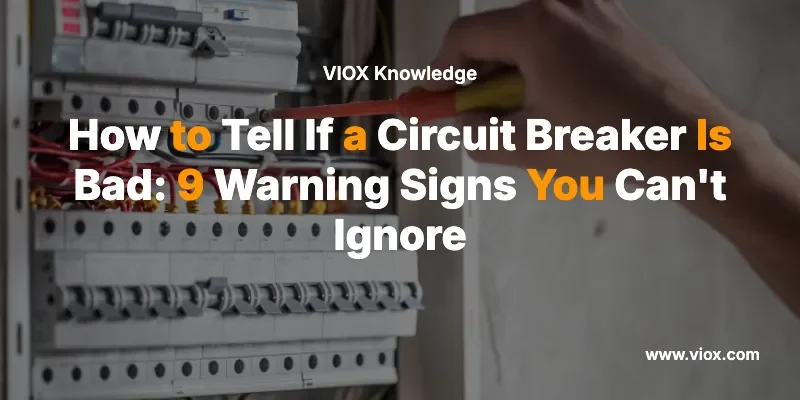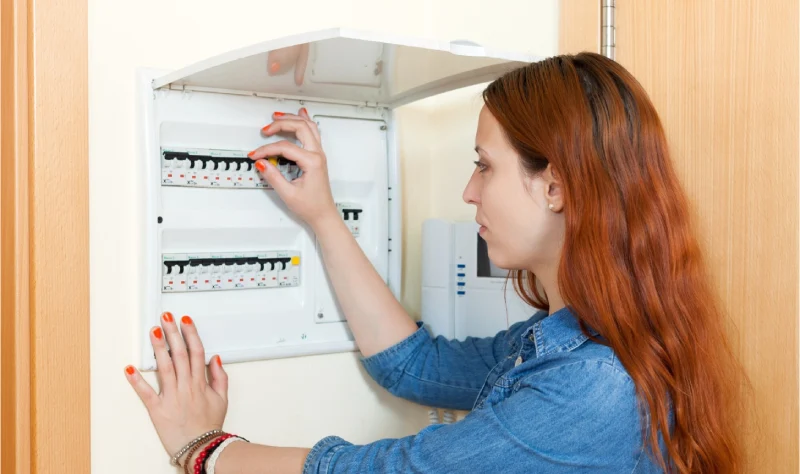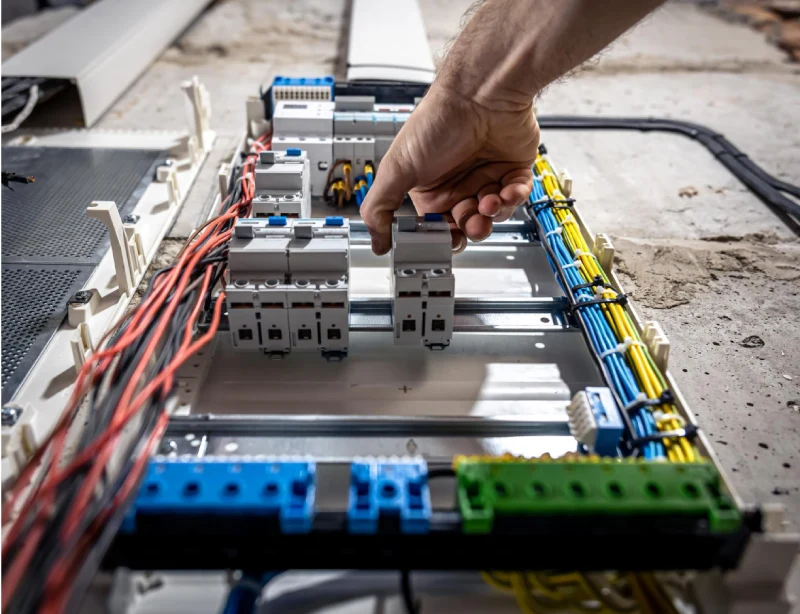Întrerupătoarele de circuit ale casei tale funcționează silențios în culise, protejând familia și proprietatea ta de pericolele electrice. Dar atunci când un întrerupător de circuit se defectează, consecințele pot fi devastatoare. Potrivit Electrical Safety Foundation International, defecțiunile electrice provoacă anual aproximativ 51.000 de incendii la domiciliu, întrerupătoarele defecte jucând un rol semnificativ în aceste incidente periculoase.
A ști cum să-ți dai seama dacă un întrerupător de circuit este defect nu este doar o chestiune de comoditate - este vorba despre siguranță, prevenirea daunelor costisitoare și protejarea celei mai valoroase investiții a ta: casa ta. Acest ghid cuprinzător te va ghida prin cele nouă semne de avertizare critice care indică faptul că întrerupătorul tău de circuit necesită atenție imediată.
De ce este importantă recunoașterea simptomelor unui întrerupător de circuit defect
Întrerupătoare sunt proiectate să reziste 30 până la 40 de ani în condiții normale, dar nu anunță când se defectează. Un întrerupător defect poate să nu se declanșeze în timpul supraîncărcărilor electrice, putând cauza supraîncălzirea firelor și aprinderea materialelor din apropiere. Asociația Națională pentru Protecție împotriva Incendiilor raportează că defecțiunile electrice sunt a doua cauză principală a incendiilor la structurile locuințelor.
Dincolo de preocupările legate de siguranță, ignorarea simptomelor unui întrerupător de circuit defect poate duce la:
- Reparații de urgență costisitoare în perioadele nepotrivite
- Deteriorarea componentelor electronice sensibile din cauza fluctuațiilor de putere
- Prime de asigurare mai mari dacă problemele electrice cauzează daune
- Valoare redusă a locuinței în timpul inspecțiilor și vânzărilor
Vestea bună? Majoritatea problemelor legate de întrerupătoarele de circuit oferă semne clare de avertizare înainte de a deveni periculoase.
9 semne clare că întrerupătorul tău de circuit este defect
1. Declanșări frecvente fără un motiv evident
Cel mai frecvent semn al unui întrerupător defect este declanșarea frecventă, care pare să nu aibă legătură cu sarcina electrică. Deși întrerupătoarele ar trebui să se declanșeze atunci când circuitele sunt supraîncărcate, declanșarea excesivă indică adesea daune interne.
Ce să cauți:
- Întrerupătorul se declanșează de mai multe ori pe săptămână
- Declanșarea are loc în timpul utilizării normale a energiei electrice
- Resetarea întrerupătorului oferă doar o ușurare temporară
- Nicio cauză evidentă, cum ar fi electrocasnice noi sau dispozitive deteriorate
Test rapid: Deconectați toate dispozitivele de pe circuitul afectat și resetați întrerupătorul. Dacă acesta se declanșează imediat fără nicio sarcină, este probabil ca întrerupătorul să fie defect și să necesite înlocuire.
TOP 5 MOTIVE PENTRU CARE MCB-UL DVS. SE DECLOCĂ ÎN CONTINUARE ȘI CUM LE PUTEA REPARA
2. Miros de ars provenit de la panoul electric
Un miros de ars provenit de la panoul electric este unul dintre cele mai grave semne de avertizare ale unui întrerupător defect. Acest miros indică de obicei componente supraîncălzite, izolație deteriorată sau conexiuni electrice defecte.
Acțiune imediată necesară:
- Opriți imediat alimentarea principală a casei dumneavoastră
- Apelați un electrician autorizat pentru servicii de urgență
- Țineți membrii familiei departe de panoul electric
- Evitați utilizarea aparatelor electrice până când problema nu este rezolvată
Nu ignora niciodată mirosurile de ars—acestea preced adesea incendiile electrice și necesită intervenție profesională imediată.
3. Întrerupătorul de circuit nu rămâne resetat
Când un întrerupător refuză să rămână în poziția „pornit” după resetare, acest lucru indică de obicei daune interne grave sau probleme persistente ale circuitului. Un întrerupător care funcționează corect ar trebui să se reseteze cu un clic clar și să rămână în poziție.
Procedura de testare:
- Asigurați-vă că toate dispozitivele sunt deconectate de la circuitul afectat
- Rotiți complet întrerupătorul în poziția „oprit”
- Rotiți-l înapoi la „pornit” și ascultați dacă se aude un clic clar.
- Dacă întrerupătorul revine imediat la normal sau se simte „moi”, este defect
Este nevoie de un diagnostic profesional: Dacă întrerupătorul nu se resetează după eliminarea sarcinilor din circuit, contactați un electrician pentru a determina dacă problema este întrerupătorul în sine sau problemele de cablare subiacente.
4. Fierbinte la atingere
Un întrerupător de circuit nu ar trebui să fie niciodată fierbinte la atingere. Deși o ușoară căldură în timpul utilizării intense a energiei electrice poate fi normală, căldura vizibilă indică o supraîncălzire periculoasă care necesită atenție imediată.
Indicații privind temperatura:
- Normal: Temperatura camerei sau ușor caldă
- Referitor la: De la cald la fierbinte
- Periculos: Prea cald ca să ții mâna pe tine
Răspuns de siguranță: Dacă descoperiți un întrerupător de circuit supraîncălzit, opriți alimentarea principală și apelați la un electrician de urgență. Întrerupătoarele supraîncălzite se pot defecta catastrofal, putând provoca incendii electrice.
5. Daune vizibile și urme de arsură
Deteriorarea fizică a întrerupătoarelor de circuit oferă dovezi clare ale problemelor electrice. Urmele de arsură, în special, indică faptul că au avut loc deja arcuri electrice periculoase sau supraîncălziri.
Listă de verificare pentru inspecție:
- Urme de arsură în jurul întrerupătorului sau panoului
- Plastic topit pe întrerupătoare sau carcasă
- Coroziune sau rugină la conexiunile întrerupătorului
- Crăpat sau spart mânerele întrerupătorului
- Urme de arsură pe componentele panoului din jur
Orice deteriorare vizibilă necesită intervenție profesională imediată. Aceste semne indică faptul că au avut deja loc evenimente electrice periculoase și că situația se va agrava probabil fără intervenție.
6. Lumini pâlpâitoare și fluctuații de curent
Pâlpâirea constantă a luminilor sau fluctuațiile de tensiune indică adesea defecțiuni ale întrerupătoarelor de circuit care nu mai pot regla corect fluxul electric. Acest simptom afectează nu doar iluminatul, ci poate deteriora și componentele electronice și aparatele electrocasnice sensibile.
Semne de avertizare:
- Luminile se sting când pornesc electrocasnicele mari
- Pâlpâire constantă fără o cauză evidentă
- Electronicele se opresc pe neașteptate
- Aparatele nu funcționează la capacitate maximă
- Motoarele funcționează lent
Sfat de depanare: Testați aceleași aparate pe circuite diferite. Dacă performanța se îmbunătățește pe alte circuite, este posibil ca întrerupătorul original să fie defect.
7. Vârsta întrerupătorului dumneavoastră de circuit
Vârsta întrerupătoarelor de circuit este un factor critic în determinarea nevoilor de înlocuire. Majoritatea întrerupătoarelor sunt proiectate să reziste 30-40 de ani, dar mai mulți factori le pot scurta semnificativ durata de viață.
Scenarii cu risc ridicat:
- Case construite înainte de 1990 cu panouri originale
- Pene frecvente de curent că mecanismele de rupere a stresului
- Circuite supraîncărcate din cerințele electrice moderne
- Factorii de mediu precum umezeala sau temperaturile extreme
Preocupare specială: Dacă locuința dumneavoastră are panouri Federal Pacific sau Zinsco, înlocuirea acestora ar trebui să fie prioritară, indiferent de vechime, din cauza defectelor de siguranță cunoscute ale acestor sisteme vechi.
8. Șocuri electrice de la aparate electrocasnice
Dacă primiți șocuri electrice ușoare de la aparate sau prize, este posibil ca întrerupătorul dumneavoastră să nu ofere o protecție adecvată împotriva defectelor la masă. Acest lucru este periculos în special în zonele expuse la apă.
Semne de defecțiune a întrerupătorului GFCI:
- Furnicături ușoare la atingerea aparatelor
- Șocuri în băi, bucătării sau zone exterioare
- Prize GFCI care nu se resetează
- Aparate care produc șocuri electrice pe mai multe circuite
Prioritate de siguranță: Șocurile electrice, chiar și cele ușoare, indică pericole grave de siguranță care necesită atenție profesională imediată.
9. Defecțiuni ale butonului de testare
Întrerupătoarele de circuit GFCI și AFCI moderne includ butoane de testare care simulează condiții de defect. Dacă aceste funcții de testare eșuează, întrerupătoarele nu pot oferi protecția prevăzută.
Procedura de testare lunară:
- Apăsați butonul „TEST” de pe întrerupătoarele GFCI/AFCI
- Întrerupătorul ar trebui să se declanșeze imediat
- Apăsați „RESET” pentru a restabili alimentarea
- Dacă întrerupătorul nu se declanșează în timpul testării, este defect
Cerință cod: Codurile electrice actuale impun protecție GFCI în majoritatea locurilor umede și protecție AFCI în majoritatea zonelor de locuit. Dispozitivele de protecție nefuncționale trebuie înlocuite imediat.
Cum să testați un întrerupător de circuit în siguranță
Metoda de inspecție vizuală
Înainte de orice testare practică, efectuați o inspecție vizuală amănunțită a panoului electric:
Măsuri de siguranță:
- Nu atingeți niciodată componentele electrice cu mâinile ude
- Folosește o lanternă în loc de iluminat de plafon
- Țineți o mână la spate în timp ce inspectați
- Să aveți un telefon mobil pregătit pentru a suna la ajutor
Listă de verificare pentru inspecție:
- Căutați deteriorări evidente, urme de arsură sau coroziune
- Verificați dacă există fire sau conexiuni slăbite
- Observați orice mirosuri neobișnuite
- Respectați pozițiile și alinierea întrerupătorului
Resetarea procedurii de testare
Acest test simplu poate ajuta la identificarea întrerupătoarelor evident defecte:
- Identificați circuitul problematic folosind directorul panoului dvs.
- Opriți și deconectați toate dispozitivele de pe acel circuit
- Opriți complet întrerupătorul, apoi din nou pornit
- Ascultați un clic definitiv la comutare
- Observați dacă întrerupătorul rămâne în poziție
Interpretarea rezultatelor:
- Normal: Clic clar, rămâne în poziția „pornit”, restabilește alimentarea
- Suspect: Senzație de moliciune, declanșare imediată, fără restabilirea alimentării
- Defect: Nu rămâne pornit, nu se aude niciun clic sau problemele continuă
Testare profesională necesară
Deși proprietarii de case pot efectua în siguranță inspecții vizuale de bază și teste de resetare, testarea electrică cu multimetre ar trebui lăsată în seama unor profesioniști calificați. Electricienii autorizați au pregătirea, echipamentul și asigurarea necesare pentru a diagnostica în siguranță problemele electrice complexe.
Când să apelezi la un profesionist vs. soluții DIY
Situații de urgență care necesită ajutor profesional imediat
Apelați imediat un electrician de urgență dacă observați:
- Mirosuri de ars de la panoul electric
- Scântei sau arcuri vizibile
- Componente electrice fierbinți
- Șocuri electrice de la aparate
- Întrerupătoare care nu se resetează după eliminarea sarcinilor
Depanare DIY pe care o poți face în siguranță
Proprietarii de case pot efectua în siguranță:
- Inspecții vizuale ale tabloului electric
- Testarea resetării de bază cu precauțiile adecvate
- Echilibrarea încărcării prin redistribuirea dispozitivelor conectate
- Verificări lunare ale butonului de testare GFCI/AFCI
Limitări importante: Nu încercați niciodată să înlocuiți singur întrerupătoarele de circuit. Această lucrare necesită expertiză electrică, unelte adecvate și cunoștințe de conformitate cu codurile, pe care le posedă doar electricienii autorizați.
Diagnostic și înlocuire profesională
Electricienii autorizați oferă servicii esențiale care asigură siguranța și respectarea codurilor:
- Diagnosticarea precisă a problemei utilizarea echipamentelor profesionale de testare
- Selectarea corectă a întrerupătorului potrivirea nevoilor dumneavoastră de panou și electricitate
- Instalare conformă cu codul respectând standardele electrice actuale
- Autorizații și inspecții electrice atunci când este cerut de codurile locale
- Acoperirea garanției pe piese și manoperă
Prevenirea problemelor legate de întrerupătorul de circuit
Sfaturi de întreținere regulată
Inspecții electrice anuale poate identifica potențialele probleme înainte ca acestea să devină periculoase:
- Programați inspecții electrice profesionale la fiecare 3-5 ani
- Testați dispozitivele GFCI și AFCI lunar folosind butoane de testare
- Păstrați panourile electrice curate și fără resturi
- Monitorizați sarcinile electrice și evitați supraîncărcarea constantă a circuitelor
Protecția mediului
Protejați panoul electric de:
- Expunerea la umiditate care pot cauza coroziune
- Temperaturi extreme care solicită componentele electrice
- Daune fizice din cauza impacturilor sau a construcțiilor din apropiere
- Intruziunea dăunătorilor care pot provoca scurtcircuite și daune
Gestionarea încărcării
Preveniți supraîncărcarea prin:
- Distribuirea aparatelor electrocasnice majore pe mai multe circuite
- Evitarea conectării în lanț a prelungitoarelor și a prelungitoarelor
- Modernizarea panourilor electrice la adăugarea de electrocasnice majore
- Monitorizarea consumului total de energie electrică în timpul utilizării maxime
Costul ignorării simptomelor unui întrerupător de circuit defect
Impactul financiar al amânării reparațiilor întrerupătoarelor de circuit poate fi substanțial:
Costuri directe:
- Tarife electrician de urgență: $200-500 pentru service în afara orelor de program
- Înlocuirea întrerupătorului de circuit: $150-300 per întrerupător instalat
- Actualizări ale panoului: $1.500-3.000 pentru case mai vechi
Costuri indirecte:
- Daune provocate de incendiu: Un incendiu electric mediu provoacă pagube de $35.000
- Implicații asupra asigurărilor: Cererile de despăgubire pot crește primele
- Înlocuirea aparatului: Fluctuațiile de curent pot deteriora componentele electronice
- Întreruperea activității: Pierderea productivității în timpul defecțiunilor electrice
Economii din prevenție: Întreținerea regulată și reparațiile la timp costă de obicei mai puțin de 10% reprezentând costuri pentru reparații de urgență și daune.
Întrebări Frecvente
Cât durează întrerupătoarele de circuit?
Majoritatea întrerupătoarelor de circuit sunt proiectate să reziste 30-40 de ani în condiții normale. Cu toate acestea, factori precum întreruperile frecvente de curent, supraîncărcările electrice și condițiile de mediu le pot scurta semnificativ durata de viață. Întrerupătoarele din circuitele cu utilizare intensă sau din mediile dure pot necesita înlocuire după 15-20 de ani.
Se poate defecta un întrerupător de circuit fără să se declanșeze?
Da, acesta este de fapt unul dintre cele mai periculoase scenarii. Un întrerupător își poate pierde capacitatea de a se declanșa în condiții de supraîncărcare, permițând în același timp fluxul de energie electrică. Acest mod de defecțiune poate duce la supraîncălzire, deteriorarea cablurilor și potențiale incendii. Testarea regulată și inspecțiile profesionale ajută la identificarea acestor „defecțiuni silențioase”.
Ce cauzează defectarea întrerupătoarelor de circuit?
Cauzele frecvente includ îmbătrânirea normală, supraîncărcările electrice, scurtcircuitele, defectele de fabricație, factorii de mediu (umiditate, temperaturi extreme) și conexiunile electrice slabe. Întreruperile frecvente de curent și fluctuațiile de tensiune pot, de asemenea, accelera deteriorarea întrerupătoarelor.
Cât costă înlocuirea întrerupătorului de circuit?
Înlocuirea standard a întrerupătorului de circuit costă de obicei între 150 și 300 de lire sterline per întrerupător atunci când este efectuată de un electrician autorizat. Întrerupătoarele speciale (GFCI, AFCI) pot costa puțin mai mult. Modernizările panourilor pentru casele mai vechi pot varia între 1.500 și 3.000 de lire sterline, în funcție de complexitate și de codurile electrice locale.
Nu așteptați ca problemele electrice să se transforme în urgențe. Dacă ați identificat oricare dintre aceste semne de avertizare în casa dumneavoastră, contactați un electrician autorizat pentru o inspecție și o reparație profesională. Siguranța familiei dumneavoastră și protecția casei merită investiția într-o întreținere electrică adecvată.
Rețineți: lucrările electrice necesită instruire și echipamente specializate. Deși acest ghid vă ajută să identificați problemele, apelați întotdeauna la profesioniști calificați pentru diagnosticarea, repararea și înlocuirea componentelor electrice.
Înrudite
Cum se înlocuiește un întrerupător de circuit
Selectarea întrerupătorului cu carcasă turnată potrivit pentru sistemul dvs. electric




